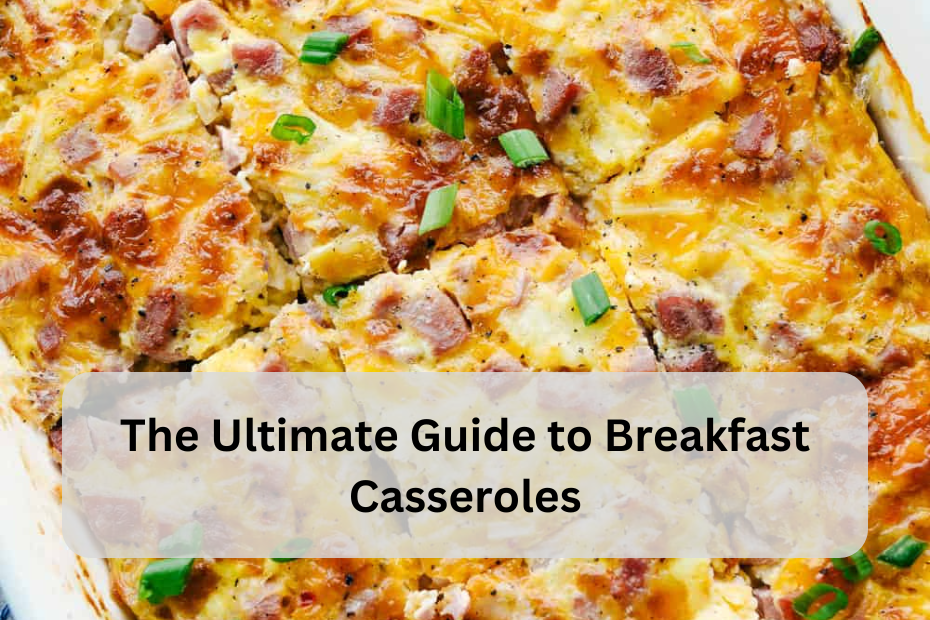Introduction
Breakfast casseroles are the epitome of comfort food, combining a variety of ingredients into one hearty and satisfying dish. Whether you’re preparing for a family brunch, hosting guests, or simply want to enjoy a filling meal, a breakfast casserole is a perfect choice. These versatile dishes can be made ahead of time, customized to suit your preferences, and are ideal for feeding a crowd.
In this article, we’ll explore the origins of breakfast casseroles, walk you through a basic recipe, discuss popular variations, and answer some frequently asked questions. Finally, we’ll conclude with why breakfast casseroles remain a beloved dish in kitchens everywhere.
The Origins of Breakfast Casseroles
Casseroles, in general, have a long history, with roots tracing back to the early 18th century when the term “casserole” referred to a type of cooking vessel rather than a specific dish. The concept of combining ingredients into a single dish and baking it in an oven has been a staple in many cultures, from French gratins to British shepherd’s pie.
:max_bytes(150000):strip_icc()/Sausage-Hashbrowns-Breakfast-Casserole-4x3-1-2000-9079fb0f906a4c0192667f41fe7627b5.jpg)
Breakfast casseroles, however, are a more recent development, gaining popularity in the United States during the mid-20th century. The rise of convenience foods and the need for time-saving recipes in the post-war era led to the creation of dishes that could be easily assembled and baked, often using readily available ingredients like eggs, cheese, bread, and sausage.
These casseroles quickly became a favorite for holiday mornings, potlucks, and weekend brunches, offering a way to feed a group with minimal effort. The appeal of breakfast casseroles lies in their simplicity, versatility, and the ability to prepare them ahead of time, making them a convenient choice for busy mornings.
How to Make a Basic Breakfast Casserole
A basic breakfast casserole typically includes eggs, a type of meat, cheese, and a carbohydrate base like bread or potatoes. The ingredients are combined in a baking dish and cooked in the oven until golden brown and set.
Basic Breakfast Casserole Recipe:
Ingredients:
- 6 large eggs
- 1 1/2 cups milk (whole or 2%)
- 1 pound breakfast sausage, cooked and crumbled
- 4 cups cubed bread (day-old or slightly stale works best)
- 1 1/2 cups shredded cheddar cheese
- 1/2 teaspoon salt
- 1/4 teaspoon black pepper
- 1/4 teaspoon garlic powder (optional)
- 1/4 teaspoon onion powder (optional)
- 1/4 cup chopped green onions or chives (optional)
Instructions:
- Preheat the Oven: Preheat your oven to 350°F (175°C) and lightly grease a 9×13-inch baking dish.
- Prepare the Bread and Sausage: Spread the cubed bread evenly in the bottom of the prepared baking dish. Cook the breakfast sausage in a skillet over medium heat until browned and crumbled, about 8-10 minutes. Drain excess fat and sprinkle the sausage over the bread.
- Add Cheese and Optional Ingredients: Sprinkle the shredded cheddar cheese over the sausage and bread mixture. If using, add chopped green onions, chives, or any other vegetables.
- Make the Egg Mixture: In a large bowl, whisk together the eggs, milk, salt, pepper, garlic powder, and onion powder until well combined.
- Assemble the Casserole: Pour the egg mixture evenly over the bread, sausage, and cheese in the baking dish. Gently press down with a spatula to ensure the bread absorbs the egg mixture.
- Bake: Bake in the preheated oven for 40-45 minutes, or until the top is golden brown and the casserole is set in the center. If the top begins to brown too quickly, cover it loosely with aluminum foil.
- Serve: Let the casserole cool for a few minutes before slicing and serving. It’s delicious on its own or with a side of fresh fruit or a dollop of sour cream.
Popular Variations of Breakfast Casseroles
One of the best things about breakfast casseroles is their adaptability. You can change up the ingredients to suit your tastes or dietary needs, creating countless variations of this classic dish.

- Vegetarian Breakfast Casserole: Skip the meat and load up on vegetables like bell peppers, spinach, mushrooms, and tomatoes. You can also add a plant-based sausage or tofu for extra protein.
- Hash Brown Casserole: Instead of using bread as the base, substitute with shredded hash browns or diced potatoes. This version is a bit heartier and has a more pronounced potato flavor.
- Mexican-Inspired Casserole: Add ingredients like diced green chilies, black beans, corn, and salsa to the egg mixture. Top with pepper jack cheese and serve with avocado and sour cream for a spicy twist.
- Gluten-Free Casserole: Use gluten-free bread or potatoes instead of regular bread to make the casserole gluten-free. Ensure all other ingredients, like sausage and cheese, are also gluten-free.
- Keto-Friendly Casserole: Focus on high-fat, low-carb ingredients by using cream instead of milk, skipping the bread, and adding plenty of cheese, bacon, and low-carb vegetables like spinach and mushrooms.
- French Toast Casserole: For a sweet version, use brioche or challah bread, and add cinnamon, nutmeg, and a touch of vanilla extract to the egg mixture. Top with a brown sugar streusel and serve with maple syrup.
- Make-Ahead Casserole: Prepare the casserole the night before by assembling it and covering it tightly with plastic wrap. Refrigerate overnight, then bake it in the morning for an effortless breakfast.
- Mini Casseroles: Instead of a large dish, divide the mixture into individual ramekins or a muffin tin for single-serving casseroles. This is perfect for meal prepping or serving a crowd with varied preferences.
Frequently Asked Questions (FAQ)
1. Can I make a breakfast casserole ahead of time?
Yes, breakfast casseroles are perfect for making ahead. You can assemble the casserole the night before, cover it, and refrigerate it overnight. In the morning, simply bake it as directed.
2. How do I store leftovers?
Leftover breakfast casserole can be stored in an airtight container in the refrigerator for up to 4 days. Reheat individual portions in the microwave or oven until warmed through.
3. Can I freeze a breakfast casserole?
Yes, breakfast casseroles freeze well. Once baked, allow the casserole to cool completely, then wrap it tightly in plastic wrap and aluminum foil before freezing. It can be frozen for up to 3 months. To reheat, thaw in the refrigerator overnight and bake until heated through.
4. What can I serve with a breakfast casserole?
Breakfast casseroles are a complete meal on their own, but they pair well with fresh fruit, a green salad, or a side of roasted vegetables. For a special brunch, consider serving it with mimosas or fresh juice.
5. How can I prevent a soggy casserole?
To prevent a soggy casserole, use day-old or slightly stale bread, which will absorb the egg mixture better. If using vegetables with high water content, like tomatoes or zucchini, consider sautéing them first to remove excess moisture.
6. Can I use egg substitutes in a breakfast casserole?
Yes, egg substitutes or liquid egg whites can be used in place of whole eggs. This is a great option for those looking to reduce cholesterol or follow a specific diet.
7. How can I make my breakfast casserole more flavorful?
Enhance the flavor of your casserole by adding herbs like thyme, rosemary, or parsley to the egg mixture. Using a mix of cheeses, such as sharp cheddar, Swiss, or feta, can also add depth of flavor.
8. What type of sausage works best in a breakfast casserole?
Breakfast sausage, either in links or bulk, is the most common choice. However, you can use other types like Italian sausage, chorizo, or even chicken sausage depending on your flavor preferences.
9. Can I make a dairy-free breakfast casserole?
Yes, you can make a dairy-free version by using plant-based milk, dairy-free cheese, and a dairy-free sausage. Coconut milk or almond milk works well as a substitute for cow’s milk.
10. How do I know when my casserole is done?
The casserole is done when the center is set and doesn’t jiggle when you gently shake the dish. A knife inserted into the center should come out clean, and the top should be golden brown.
Conclusion
Breakfast casseroles are a versatile and comforting dish that has rightfully earned a place in kitchens around the world. Whether you’re preparing a classic version with sausage and cheese, experimenting with vegetarian or gluten-free options, or creating a sweet French toast casserole, there’s a recipe to suit every taste and occasion.
The beauty of breakfast casseroles lies in their simplicity and adaptability. They can be prepared ahead of time, customized to include your favorite ingredients, and are perfect for feeding a crowd with minimal effort. As a go-to dish for holidays, weekend brunches, or busy weekday mornings, breakfast casseroles offer a delicious, hearty meal that’s sure to please everyone at the table.
From their humble origins to their status as a beloved breakfast staple, casseroles continue to be a symbol of comfort and togetherness. So the next time you’re looking for a breakfast or brunch option that’s both easy and satisfying, consider whipping up a breakfast casserole—you’ll be glad you did.
Read Also: Naan: The Irresistible Bread with a Rich History
